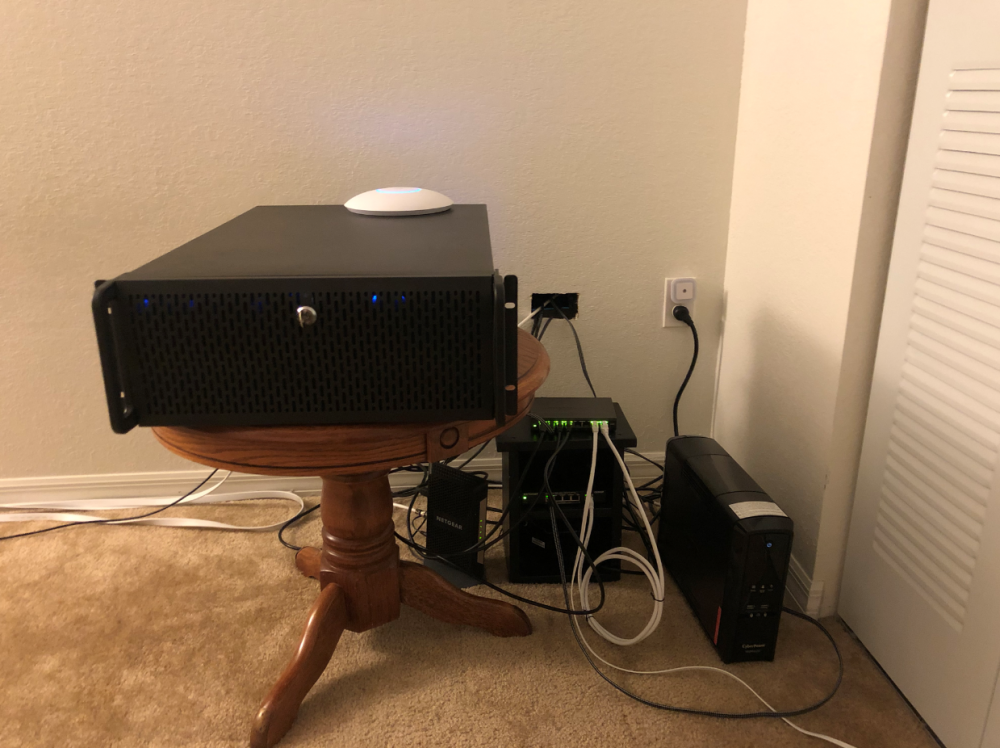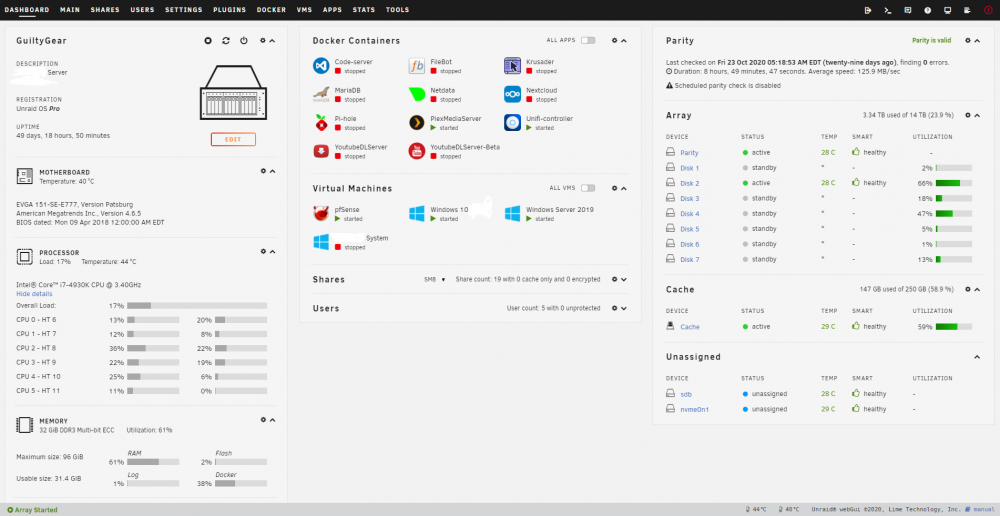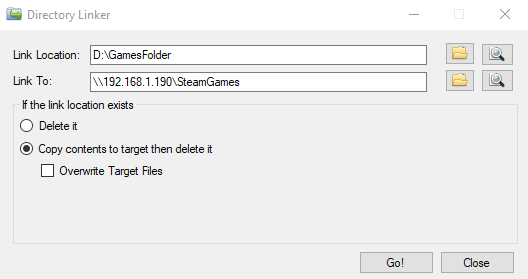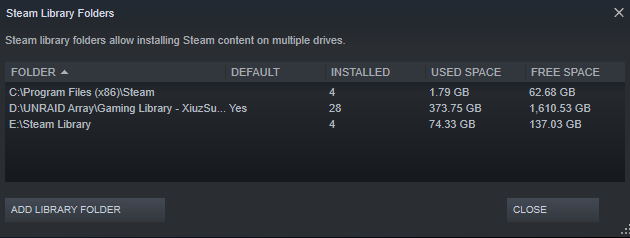-
Posts
180 -
Joined
-
Last visited
Content Type
Profiles
Forums
Downloads
Store
Gallery
Bug Reports
Documentation
Landing
Posts posted by JustOverride
-
-
- Updated 6.9.1 -> 6.9.2 without issues....except
QuoteWARNINGS FOUNDSUGGESTED FIX
Share Public Programs Share set to prefer a cache pool, but will not move Due to a current issue in Unraid 6.9.2, shares with spaces in them will never get moved to the cache pool. Advised to rename the share without using a space
-
Updated from 6.9.0-rc2 -> 6.9.0, and everything went well! Thank for the upgrade!
-
On 1/23/2021 at 9:13 PM, bergePanzer581 said:
Great post! Big question though I'll ask, without having tested your method obviously-- how agout EA's Origin? Origin, is a finicky thing. EA from my experience, went out of its way to prevent simlink drives and NAS directories for game storage. Are you able to test this method with Origin, and if you have already-- does it work?
It was "kinda" working. While it would work sometimes, upon close/re-opening origin or restarting the computer, it would suddenly not find the game and prompt for a re-download/install of the game. During the install you have to key in the path as it also won't just let you select it normally. They are REALLY against it, don't know why.
-
 1
1
-
-
Well it can be used for online stores like uplay and epicgames which don't support the mapping of a network. However, there was another reason. I just honestly forgot.
-


It was my older gaming computer. How it all began.......----------------------------------------------------------------------------------------------
Let me know what you guys think.
-
 1
1
-
 1
1
-
-
8 hours ago, steve1977 said:
I seem to face the same issue. But just with one my VMs. I have a Windows VM (with GPU passthrough), which works very well. I also have a MacOS VM (with a different GPU passthrough), which crashes Unraid upon rebooting from within the VM.
I don't fully understand what I need to add where to fix this. Any chance you can help elaborate?Sure, to help you, what is your server specs, is it x79 platform?
Have you edited the XML files in the VM for the passthrou?
Are the drivers up-to-date?
Have you edited the bios on the graphics ROM to remove the header?
I haven't tried a Mac OS yet only windows.
-
Yea, the second part <alias name='hostdev1'/> is the sound portion of the graphics card. I believe everything should be good now. Let me know if you have any issues.

-
Ok, yea that's perfect like that.
-
Just now, softfeet said:
Is this section critical?
Yeaaa. just post your XML after you have added the edited rom and GPU passthro, and I'll edit it for you.
-
Just run UUD (there is an option to stop windows from installing drivers temporarily). Uninstall the drivers, install the latest ones, then untick the windows option to continue to install drivers when done.
You may also want to try running the VM with the emulated video hardware and see if you experience issues.
(edit) I just remember, make sure to edit your XML and under the graphic card section, you make it look like this.
<alias name='hostdev0'/> <rom file='/mnt/user/isos/GTX - Bios Dump/Updated Asus GTX 1050 Ti.rom'/> <address type='pci' domain='0x0000' bus='0x00' slot='0x05' function='0x0' multifunction='on'/> </hostdev> <hostdev mode='subsystem' type='pci' managed='yes'> <driver name='vfio'/> <source> <address domain='0x0000' bus='0x01' slot='0x00' function='0x1'/> </source> <alias name='hostdev1'/> <address type='pci' domain='0x0000' bus='0x00' slot='0x05' function='0x1'/>
with the 'multifunction='on'
And change the next pci line to match the same slot as the first, then change the function to match the same function +1 as shown above.
Note: When you edit XML, if you go back to the regular settings and change something and save it, you have to go back to the XML to make this change as it will be changed back to default.
-
12 minutes ago, softfeet said:
Just had the unraid system lock up again. Was logged into win10 machine via parsec. Hit the shutdown button from the start menu. Entire network came to a grinding halt.
network usage:
two cifs connections open to two osx computers. (share mounted, not utilized for stream or transfer)
smb mount in vm of linux. active data being transferred from wan to smb mount.
nfs4 connection from above linux vm2. with active file transfer from wan.
the win10 vm up. has a smb connected share to unraid.
iscsi vm running with network share to linux vm.
Everything works fine until the win10 vm is shut off. then unraid goes into network hell and the entire network grinds to a halt. packet blender.
This is with the dumped rom file for the video card.
I don't get it. This makes no sense. I would look at logs... but dont know exactly what to look for in a usb based system. .
Did you edited the rom file as well?
Cleared old drivers and re-installed them?
Tried making a new VM (using the same vdisk) but without the GPU passthro? If so, does it crashes then?
Do you still have "pcie_no_flr=1022:149c,1022:1487" on your unraid settings section?
-
1 hour ago, softfeet said:
I had tried space invader's video on a first go through. It didn't work for me though. I dumped, found a bios file online. But found that just passing through worked... to a point. per the thread.
I am not familiar with DDU.
Can you explain why the options you are mentioning would help with my specific problem? I dont want to spend a lot of time trying something if it does not have a rational for being a solution. That is, I dont want to spend hours testing other people's theories unless I am sure that it is a guess and check session.
This issue is likely due to the graphics card passthro. You can confirm this by running the VM without the graphics card being passthro. If it doesn't crash anymore, well there's your problem. Feel free to test it by removing the graphics card passthro.
The drivers being mixed in with windows drivers or older nvidia drivers may cause an issue as well which is why I suggested you try DDU, and then install new drivers.
The bios from the website didn't quite work for my graphics card. I just put it in another system, and ran gpuz to extract the bios directly from my graphics card. Then use a hex editor to remove the header.
-
Hello,
Have you use an edited bios for the graphics card removing the first part of it? SpaceInvader made a video on how to do it. Also, you may want to try DDU to uninstall the graphics drivers and install the latest one.
-
I hope this gets fixed on UNRAID 6.9. My WSDD still disabled.
-
 1
1
-
-
7 hours ago, yogy said:
I'm fairly new to unRAID but I'm experiencing the same issue when shutting down/restarting VM. I've been reading the forum regarding this issue for the last 3 days and I've done all the necessary steps suggested to prevent this, but without luck.
Question for @peter_sm. Where exactly did you add those parameters. I know they should be in Syslinux configuration but don't know exactly which line. Should I put exactly the same parameters (1022:149c,1022:1487) or ..... <<confused>> Do they still work or you did some neww "modifications"?
@Karatekid would you mind explaining switching from X79 to X99?
Add the paremeters to the flash drive settings, under Syslinux Configuration. Same place where you add the graphics card IOMMU.
-
This guide will help you setup an UNRAID share to be used as an steam install folder with a higher success rate than other options.
Things you will need;
a) Another drive other than C:\. (otherwise you would need to create a "fake" drive via a regedit.
b) Download this program to make a hard link, Dlinker.
1) If you haven't already, create a share on UNRAID that you wish to use for the installation and storage of your steam games. Lets call it SteamGames
2) Create a folder on another drive other than the default steam install drive (this is usually in C:\). So create a normal folder on D:\GamesFolder that we're going to use to point to the server.
3) Using the program we just downloaded, Dlinker, fill the information as shown below.

192.168.1.190 <- This should be your UNRAID server's IP address.
SteamGames <- This should be your UNRAID share gaming share's name.
Then press 'Go!'.4) On steam, navigate to View -> Settings. Go to the Downloads tab on the left. Then click on 'Steam Library Folders'. Add the folder we created earlier, D:\GamesFolder.
5) THAT'S IT! You may begin installing and running games normally.
Things to Note :- DO NOT delete the created folder D:\GamesFolder as this will also delete any files/folders to the linked share in UNRAID. There is A LOT of misinformation online about deleting this type of hard link. What I found to work best, and safest is to temporary disconnect the connection to UNRAID by unplugging the ethernet cord (or stop all network connections) and deleting it normally. This way you will not lose any information in your share.
- If unraid is offline, your games won't show, but you can still use your steam normally and play any games that were store in other locations or your local drive.- Some games, won't want to install with this setup. Personally, I have only encounter this issue with 1 game using this approach. This was with 'World of Final Fantasy'. In this case, I just installed it to C:\, then moved it to the array and haven't ran into any other issues. I have over 250+ games.

-
3 hours ago, trurl said:
Don't put it on the internet. If you need remote access Wireguard VPN is builtin.
Just wondering, does this mean that having Plex running as 'host' and opening up that IP (which would be the same as UNRAID), and thet port for plex would also open UNRAID as well to the internet? Or am I OK with the way I've done it?
-
3 minutes ago, axipher said:
WS discovery is a welcome convenience on my network and I would prefer to leave it running, is it possible to maybe lock it to a specific core to play more nicely with Docker and VM CPU Pinning settings?
As it stands, I use CPU pinning to give VM's and Docker Containers access to certain cores to help with higher CPU dependent things like a game server or Plex container, so it would be nice to just throw WS Discovery on specific cores that aren't shared with the CPU dependent stuff.
There isn't a way to specify a core for this function. Additionally, when the issue happens, the core that is at 100% may hoop to another core.
-
1 hour ago, itimpi said:
It might be worth reading this section of the online documentation to understand why writing to the array is slower than writing to a drive that is not part of the array.
Yea, I know about the write details but went ahead and gave it another read. For my use scenario read/modify/write works best for me as I don't want all my drives spun up. My question is, why is copying from a VM to the Array (which is using a cache SSD, VM is on separate SSD) is maxing out like if it was using a 1GB ethernet connection. My main system using the 1GB ethernet connection makes the same copy at the same max speeds to make the same copy (110 MB/s). However, my main system using the 10GB ethernet connection copies the same file at 650 MB/s. So again, I'm just wondering why the VM which is in the same system as UNRAID does not make the copy to the array at max available speeds. Is it because is using SMB and there for going through a virtual interfaced capped at 1GB? ... Did I just answered my own question?
"The auto method has been for the potential of the system automatically switching modes depending on current array activity but this has not happened so far. The problems is knowing when a drive is spinning, and being able to detect it without noticeably affecting write performance, ruining the very benefits we were trying to achieve. If on every write you have to query each drive for its status, then you will noticeably impact I/O performance. So to maintain good performance, you need another function working in the background keeping near-instantaneous track of spin status, and providing a single flag for the writer to check, whether they are all spun up or not, to know which method to use."
This part from the documentation, why can't we just keep a on log running on UNRAID in RAM for when was the last read/write to the drive. Knowing this plus knowing the spindown setting means we can know if the drive is still spinning. Actually, doesn't the spin-down command comes from UNRAID? Why can't we log when we last sent it for each disk. A combination of both? This way we would be able to use AUTO for things like rebuilding parity's or heavy write loads.
Maybe in the future we can also get the disk write options separated by pools.
-
I've been wondering this too, just haven't gotten around to look into it.
-
I'm still on the 6.8.3 since its just on my main system and can't risk data corruption. Sorry.
-
Would love to test it, just don't have a test system yet.
-
+1 from me too!
Mainly for pfSense, but also because ALL of my VM's are on a separate unassigned drive. I think the majority of users have their setup mostly this way due to the inexpensive SSD's cost and the large performance gains. -
I would like to add that there are also some registry edits you can do to make the VM appear as a real PC. I don't have the specific edits, but they are googleable, and very easy to apply. I've used them before, took about 5-10mins.




















Unraid OS version 6.9.2 available
in Announcements
Posted
Is this a fix that will be coming to unraid, or should I just change the name of the share?